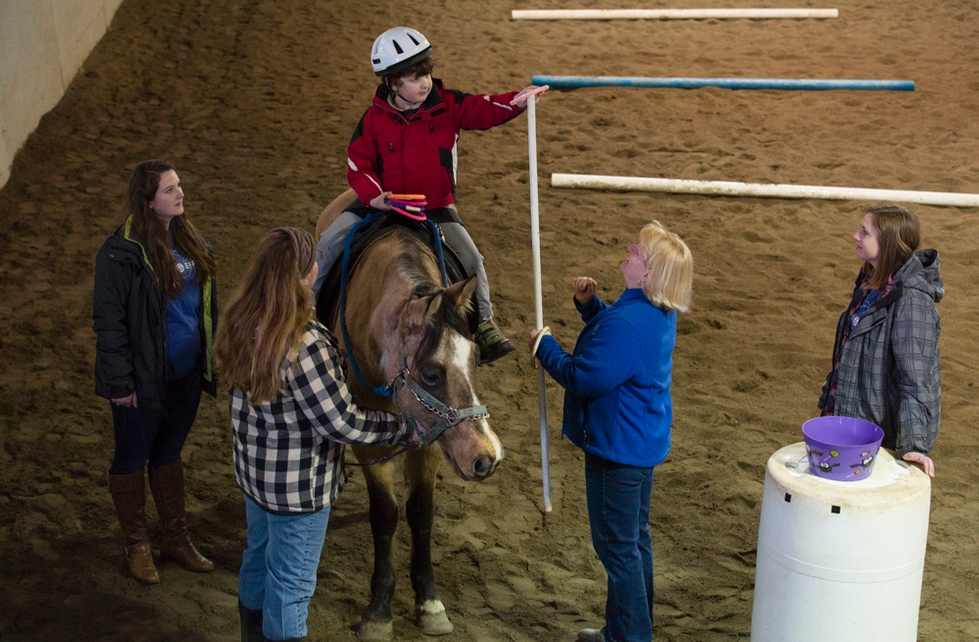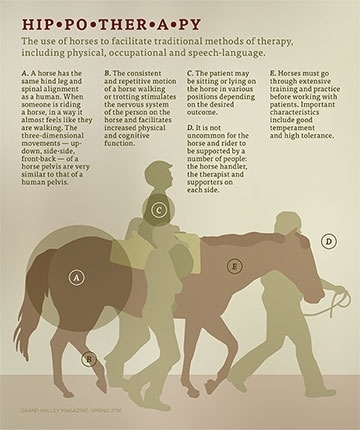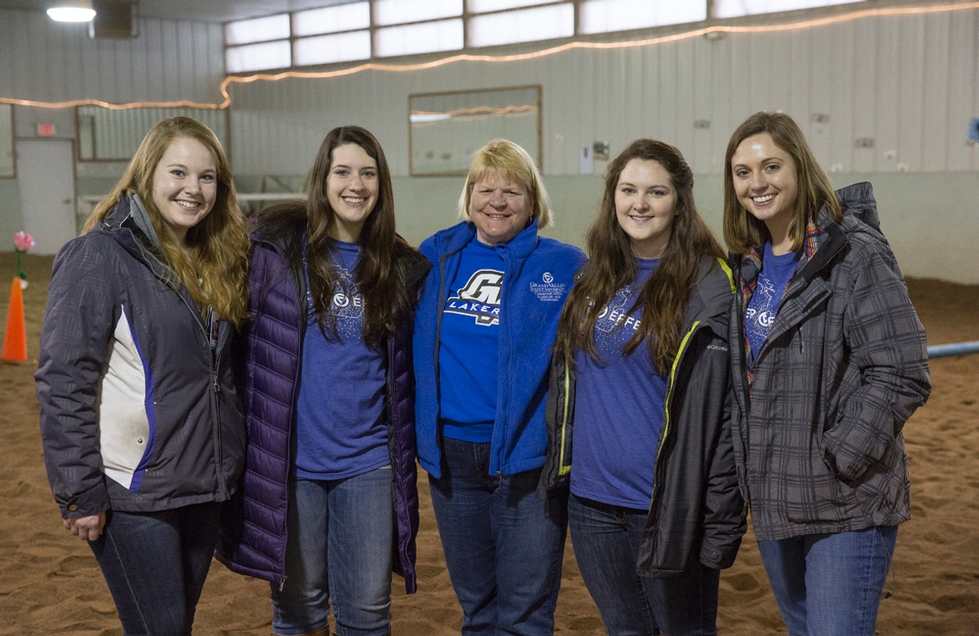Saddle up
Professor leads research on emerging speech therapy technique
by Leah Twilley
photos by Elizabeth Lienau
video by Tony Packer
“What do you like on your pizza?” asked Beth Macauley.
“Pep-pe-ro-ni!” said Davide Sirilli, sounding out each syllable.
“Good. Now say that in a full sentence,” said Macauley.
“I like pep-pe-ro-ni on my pizza,” Davide answered.
This small exchange is a big deal for Davide, a 7-year-old boy with autism spectrum disorder. Every week for the last three years he has come to Children and Horses United in Movement (CHUM) in Dansville to receive occupational and speech therapy while riding a horse in an effort to improve his fine motor and speech skills.

Davide Sirilli, 7, receives hippotherapy once a week on Twiz at Children and Horses United in Movement in Dansville.
“Davide has come a long way,” said his mother, Nada Sirilli. “He’s now at the top of his class at school.”
The type of therapy Davide receives is called hippotherapy, which is the use of horses to facilitate traditional methods of therapy, including physical, occupational and speech-language. The latter is the most recent type of therapy to use hippotherapy as a technique, said Beth Macauley, associate professor of communication sciences and disorders in the College of Health Professions.
Macauley is one of four speech-language pathologists in the U.S. with board certification in hippotherapy. She is giving Grand Valley students hands-on opportunities to learn and practice this emerging speech therapy technique.
Growing up, Macauley loved horses and helping others, so naturally, she wanted to combine her two loves into a career. She was first introduced to hippotherapy as a physical therapy technique in 1985 when she was a Special Olympics equestrian coach while attending college at the University of Florida.
That’s when she realized that the human nervous system controls not only physical aspects, but also a person’s ability to speak, which is when Macauley started to incorporate speech therapy into the Special Olympics equine program. Hippotherapy as a speech therapy technique has been the focus of her research since then.
“Hippotherapy is a clinical skill that requires extra training in order to use it. Instead of going into a room and using books and cards for speech therapy, you’re now doing those same activities on a horse,” said Macauley.
Lasting effects
Alex Decker was not certain that hippotherapy really worked. She thought a therapy session on a horse couldn’t possibly improve speech.
But Decker, who graduated with a master’s degree in speech-language pathology in April, said she was intrigued by the technique.
“I started looking into it and found that Dr. Macauley is one, if not the only, published researcher to use hippotherapy for speech therapy. It seems really cool to be a part of something that is so groundbreaking,” said Decker, a native of Grand Blanc.
Despite her reservations, she decided to volunteer and attend one of Macauley’s weekly trips to Cheff Therapeutic Riding Center in Augusta, a facility that is certified to offer hippotherapy services. She worked with a woman who had a traumatic brain injury from a car accident. Macauley led the therapy sessions and Decker helped facilitate them.

Click here to enlarged version of this image.
“Before our patient got on the horse it was hard to understand what she said. Her speech was slurred, her volume was low and she had poor trunk support,” Decker said. “By the end of the therapy session, she was cracking jokes, in a good mood and I could understand everything she said. “Hippotherapy worked and it was incredibly rewarding.”
Connor Braaten, who also graduated with a master’s degree in speech-language pathology in April, spent many clinical hours practicing and understanding hippotherapy with Macauley.
“The reason using horses is so beneficial for our clients is because a horse has the same hind leg and spinal alignment as a human,” Braaten said. “When someone is riding a horse, in a way it almost feels like they are walking.”
Macauley said that the three-dimensional movements — up-down, side-side, front-back — of a horse pelvis are very similar to that of a human pelvis. “When a person with a physical disability is on a horse, the horse’s intact nervous system becomes a framework for that person,” she said.
Hippotherapy started as a physical therapy treatment for children with cerebral palsy, then it was used for adults with polio and brain injuries. Over the years, the technique expanded from helping to improve physical conditions to improving speech, language and cognition. Macauley has worked with children as young as 2 years old and also with elderly patients who have experienced strokes.
The exercises Macauley uses depend on a patient’s goal. Decker’s goal while she worked with the woman with a traumatic brain injury was to establish muscle patterns and practice speaking and sustaining vowels. “Then we would make it more complicated by working on longer words like ‘megalomaniac,’” Macauley said. “We see clearer, more articulate speaking after a person gets off a horse.”
During one study, Macauley had a patient tell a short story before and after a hippotherapy session. She found that word choice and complexity of sentences were improved after the patient had been on the horse.
It works, but how?
Macauley said she gets a frequent question: How exactly does it work?
“We don’t quite understand how it works yet,” Macauley said, “but we have a theory: the consistent and repetitive motion of a horse walking or trotting stimulates the nervous system of the person on the horse and facilitates increased physical and cognitive function. We use this to our advantage to work toward the person’s treatment goals. Since the nervous system is given a coordinated, integrated framework from which to function, it can focus on bigger, more complex thoughts, words and movements.”
For example, a young girl who has a brain injury has worked with Macauley to improve her speech.
“We’re working to improve her core so she has better breath support and range in her lungs, so we lay her down on the horse and that expands the whole rib cage and shoulders. The movement of the horse massages and stimulates her so she can maintain her posture when she sits up. This results in a louder voice and clearer speech,” she said.
With Davide, Macauley said, the movement of the horse facilitates his attentional system so he is able to focus on improving his expressive and receptive language.
In the future, Macauley hopes to lead a study that focuses on analyzing data of the activity of a patient’s brain during hippotherapy. She also hopes the therapy technique will eventually be covered by insurance companies.
“Speech therapy is covered by most insurance companies, but when you tell the company that a horse is involved, they think ‘pony rides’ and decline to pay. If I was able to document, through research, that hippotherapy is an effective and efficient treatment strategy within speech therapy, I believe that more insurance companies would not just cover the services but seek out qualified providers for their members,” she said.
No horsing around
Not just any horse can be saddled up and used during hippotherapy sessions. They must go through extensive training and practice. At CHUM, where Macauley currently conducts speech therapy treatment and research, 16 trained horses serve children and adults with a variety of diagnoses.
CHUM founder and occupational therapist Bonnie DePue has spent more than 35 years learning about the uses of horses in medical treatments. She said her horses must have good temperament and high tolerance, as they often work in a small space with a lot of people.
DePue said during therapy sessions it’s not uncommon for the horse to be surrounded by four to five people: the client, the horse handler, the therapist and supporters on each side of the horse, so the horse can’t be claustrophobic.

Students visited CHUM with Macauley during a hippotherapy session in February. From left are Kaylie Lobb, Caitlin Karelitz,Macauley, Denice King and Tenika Garteiz.
When Davide visits CHUM for his weekly session, he rides Twiz, a 9-year-old, quarter horse and mustang mix gelding.
“He’s come so far with his speech,” DePue said. “It’s because of the rhythm he experiences while riding Twiz. The rhythm of movement has helped his breathing, which has improved his articulation and speech.”
Macauley said the horses must have very symmetrical, rhythmic and subtle movements throughout all limbs. They must also tolerate all types of patient challenges, like spasms and screams.
“Each horse is evaluated for what it would bring to the program,” Macauley said.
Looking ahead
The speech-language pathology program at Grand Valley continues to grow. The program was established in fall of 2010 in the College of Health Professions with 20 undergraduate students. Macauley has led its growth to include more than 120 undergraduates and 70 graduate students in the fall of 2015.
Macauley said within five years, Grand Valley went from not having a SLP program to being at maximum capacity at the graduate level and near capacity at the undergraduate level. Last fall, more than 400 individuals applied for the 30 spots in the graduate program. Today, graduates are working in the field in six states.
First-year graduate student Tenika Garteiz, from Montana, said she chose Grand Valley’s program because of the opportunity to learn and practice hippotherapy. In high school she volunteered at a therapeutic recreational facility and did her senior project on autism and animal-assisted therapy. Like Macauley, she wants her career to focus on combining her love for horses and helping others.
Garteiz’s first experience with hippotherapy was during a visit to CHUM in February. Her job was to observe Macauley from the sidelines of the large indoor arena.
“It was an incredible experience to see the determination of her patients and how well she works with them. It reaffirmed my goal to continue to work with horses while helping people,” she said.
